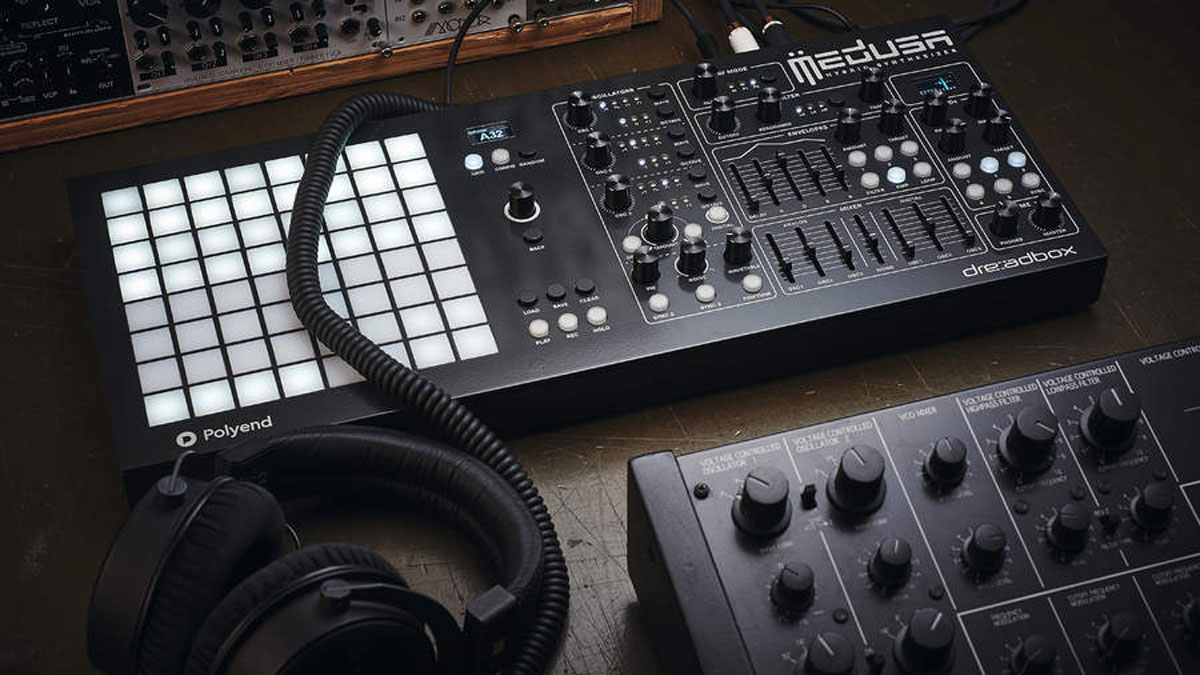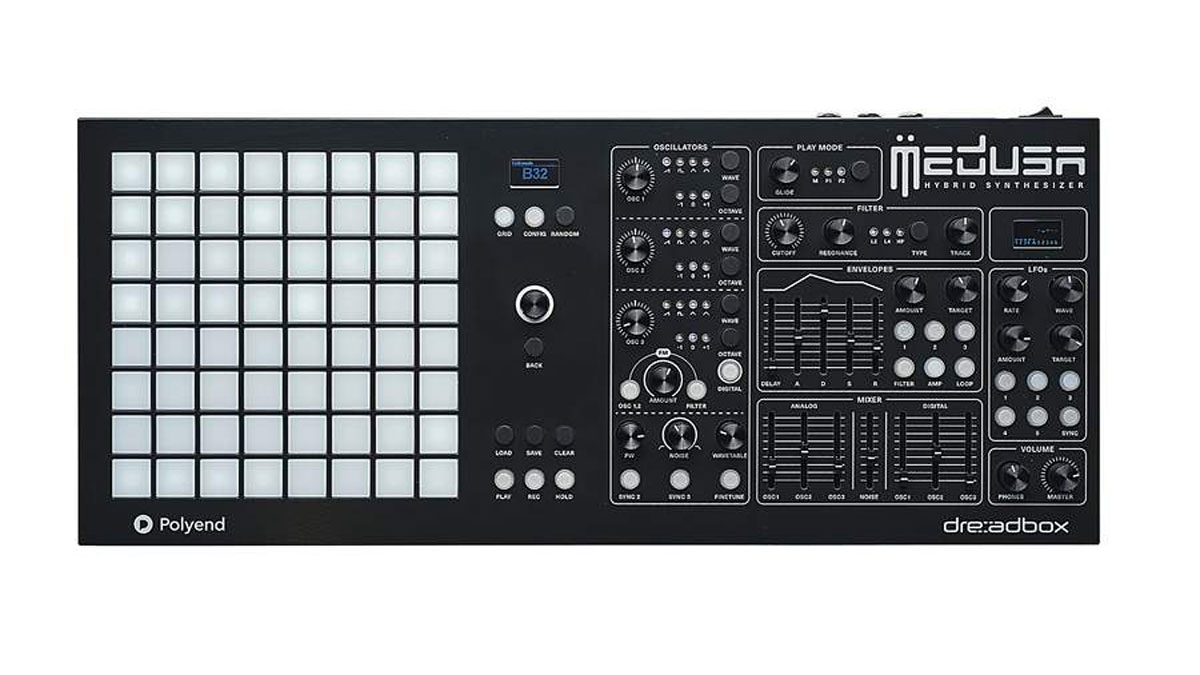MusicRadar Verdict
Medusa is a unique analogue/digital hybrid synth with a lot of future potential, but right now it’s still a bit of a work in progress.
Pros
- +
Characterful analogue/digital synth engine.
- +
Sequencer and pads have lots of potential.
- +
Plenty of modulation.
Cons
- -
Several important sequencing features yet to be added.
- -
No onboard effects.
- -
Presets don’t really show off Medusa’s full potential.
MusicRadar's got your back
Medusa is the result of a collaboration between two of the most interesting boutique brands in Europe.
The first of these is Dreadbox, the Athens-based outfit behind a growing roster of analogue synths, including the impressive NYX and Hades monosynths and its excellent flagship poly, Abyss. The other side of the equation comes from Polish brand Polyend, who has impressed us in the past year with the forward-thinking Seq sequencer and the Perc Pro MIDI drummer.
Unsurprisingly, Medusa is comprised of an analogue synth engine supplied by Dreadbox paired with digital synthesis and sequencing tools developed by Polyend. This is more than just a simple case of strapping a digital step sequencer to a subtractive synthesiser though; features such as wavetable oscillators, three-dimensional playable pads and full parameter sequencing aim to make this an instrument that can do cutting-edge sound design just as well as it does vintage analogue.
At its core, Medusa is a six oscillator synth with three analogue and three digital sound sources. It can be switched between three play modes, the first of which has it operating as a six oscillator monosynth, while the latter two offer two different types of paraphonic operation. The first of these allows for three notes of polyphony and has the oscillators operating in pairs - where each voice has a single analogue and digital oscillator assigned to it. The final mode allows Medusa to play up to six notes using each oscillator as a separate voice. The analogue oscillators offer four waveshapes - saw, square, triangle and sine - with a switchable range of three octaves and a separate tuning rotary handling both fine and course tuning adjustments up to +/-12 semitones. A shared pulse width rotary adjusts the square wave of all three analogue oscillators simultaneously. There is a pair of sync buttons for syncing osc 2 to osc 1 and osc 3 to osc 2.
It’s also possible to engage exponential frequency modulation of oscillators 1 and 2 by oscillator 3, with a rotary controlling the amount applied. The digital oscillators offer the same tuning controls and four waveshapes as their analogue counterparts, but also add a fifth wavetable mode. The three digital oscillators share a single wavetable between them, which can be selected from an available list of 20 in the synth’s option menu. A rotary in the oscillator section adjusts the wavetable start position for all three digital oscillators simultaneously, but the position of each can be modulated independently by the envelopes and LFOs.

The oscillators are joined by a noise source, which has its own adjustable bi-directional filter for changing its tonal quality. The individual levels of these seven elements can then be set using faders in the mixer section.
Medusa’s filter has three modes - -12dB and -24dB low-pass and -6dB high-pass - and has a resonance control that can be pushed up into self-oscillation. There’s also a continuous keytracking control for adjusting how much the cutoff follows incoming notes. Medusa can also engage audio rate modulation for the filter, using analogue oscillator 3 as the modulation source. Used in small doses, this is great for adding a little distortion and grit to the sound.
Want all the hottest music and gear news, reviews, deals, features and more, direct to your inbox? Sign up here.
Modulation for the synth engine is provided by five envelopes and five LFOs. The envelopes all share a single set of control sliders and are in delay-attack-decay-sustain-release format.
Of the five envelopes, the final two are hard-routed to the filter and VCA; all envelopes can be routed to one of 35 selectable destinations though, either by selecting a routing using the Target rotary or by simply holding the envelope’s selector button and adjusting the desired control. The envelopes are all loop-able too, allow each to function like a shapeable LFO. The five dedicated LFOs are all assignable to the same list of destinations as the envelopes. Each has a continuous shape control for adjusting the wave, a rate control with a range between .01Hz to 30Hz and switch for syncing the LFO to master tempo. The rate and shape of each LFO is available as a mod destination for both the LFOs and envelopes, making it possible to set up some interesting complex and evolving modulation routings.
The hardware itself feels solid and looks pretty neat and stylish. The design of the interface might prove a bit divisive, as it uses shared controls for a lot of elements - the analogue and digital oscillators share a control section, and there are single control sets for the envelopes and LFOs - but personally we do find it to be a fairly neat solution and on the whole we must say we like its approach to designing sounds.
Sonically, the synth engine is pretty versatile and can create some unique, impressive sounds, although it takes a little getting used to. The analogue oscillators alone have the warm, characterful quality Dreadbox has become known for, and can do both gritty rasping leads and basses and thick, warm analogue tones with ease. The digital oscillators are handy for adding extra weight and character - in standard waveshape modes they’re good for adding extra thickness, particularly when used as sub-oscillators, while the wavetable modes can add complexity over the more simple analogue waveforms.
On the wavetable front, Medusa’s stock of wavetables work better when blended into sounds to add a subtle layer of texture than when used as the basis for sounds on their own - they have plenty of character but lack weight and warmth. While it’s a shame not to be able to assign different wavetables to each individual oscillator, the ability to modulate each separately offers enough scope for variety.
Along with acting as a 64-step sequencer, Medusa’s pads offer an expressive playing surface with assignable, MPE-like capabilities. Essentially, as well as registering note on/off and velocity, each pad can also track a finger’s directional movement, like a miniature X/Y pad, and aftertouch pressure (labelled the Z axis). These X, Y and Z control messages are linked to pitch and mod wheel and aftertouch inputs, when using Medusa with an external controller, and all three can be assigned to the same list of modulation destinations as the LFOs and envelopes. In practise, this can take some fairly precise configuration in order to get effective results, and works better in some situations than others. The X and Y axes require pressure to register, so it’s difficult to control modulation using these without triggering Z. With a little experimentation, it’s possible to achieve some interesting results though. Future updates will also allow Medusa to act as an MPE-style controller for external gear and plugins. Medusa also offers an extensive collection of preset scales for use when playing the pads in Notes mode, making it easy to experiment with ideas.
The filter sounds great in all modes, although the resonance ramps up into harsh levels quickly - subtlety is required when dialling it in. The same can be said for the oscillator frequency and filter modulation: great for adding a gritty, inharmonic quality to sounds, but best used with a light touch. These inharmonic elements, paired with the plentiful modulation options, mean that Medusa excels at evolving ambient sounds and synth tones that walk a fine line between melody and atonality - basically Boards Of Canada fans will love it!
On the negative side, with no onboard effects, Medusa can sound fairly dry without external processing. Other Dreadbox synths - NYX, Abyss - include gorgeous characterful effects units, and the lack of even a simple digital reverb or delay here does leave Medusa sounding a little ‘smaller’ than those instruments. There’s a lot more to Medusa than just the synth engine though. The sequencer side is composed of 64 rubber pads which can be used in two modes: Notes, where the pads act as a playable ‘keyboard’ based around a pre-selected scale, and Grid, in which each pad represents a sequencer step. These two modes aren’t entirely unconnected though, as sequences can be inputted or recorded in either view. It’s not just note data that can be recorded to the sequencer - each of the 64 pads can store settings for any synth engine parameter. These can be recalled, along with note data, by hitting any pad in Grid mode.
Alongside this and the interesting 3D expression [see Pads, Scales and Expression], Medusa also features a cool randomiser, which allows for separate randomisation of sequencer data and/or synth parameters. For all its potential though, at the time of writing the digital elements of Medusa feel like a work in progress. This is particularly evident on the sequencer side. Right now, for every deep tool there’s a fairly basic feature missing: there’s currently no way to change note lengths or add tie notes, MIDI sync and CC control is yet to be implemented and, while polyphonic sequencing is achievable by playing in chord shapes in Notes mode, there’s no way to edit or assign multiple notes in the Grid sequencing mode.
If we were being picky too, we’d like the addition of an arpeggiator of some kind alongside the sequencer. User wavetable import would be a great future addition too, and would add a whole extra dimension.
Polyend has supplied us with beta firmware that fixes a number of these things - such as adding proper USB MIDI functionality - and we’re assured others will follow very soon. From our experiences of dealing with the developers, we have every faith that Medusa will continue to be updated, both to add necessary features and respond to user requests. In fact, it may well have implemented many of these things by the time you get around to reading this. However, we’re basing this review on the version of Medusa that’s publicly available at the time of writing, and if you pick the instrument up right now, you’re potentially buying into a synth that is yet to reach a fully functioning state.
That said, there’s a lot of potential to Medusa, and while some features need adding or refining, the underlying synth engine offers something unique in a crowded market. Even with the coming updates, it’ll likely prove a bit esoteric for those wanting an ‘all-rounder’ synth, but for a forward-looking instrument with unique character and ideas, Medusa is worth keeping an eye on.
I'm the Managing Editor of Music Technology at MusicRadar and former Editor-in-Chief of Future Music, Computer Music and Electronic Musician. I've been messing around with music tech in various forms for over two decades. I've also spent the last 10 years forgetting how to play guitar. Find me in the chillout room at raves complaining that it's past my bedtime.
